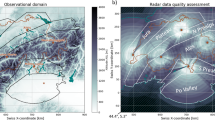Abstract
When convection develops into a thundercloud stage of at least moderate intensity, its cellular appearance may be monitored not only with weather radars but also with lightning location systems. For intense thunderstorms, the ground-flash rate alone is sufficient for making apparent the underlying convection-cell structure. if flash cells can be properly identified, they show longitudinal development complementary to the usual view of advancing transverse front. A method is described to analyse the flash-cell structure of thunderstorms and is illustrated with an example from Finland. With proper choice of parameters, the largest, most interesting flash cells generally have realistic sizes, lifetimes and motion.
Access this chapter
Tax calculation will be finalised at checkout
Purchases are for personal use only
Preview
Unable to display preview. Download preview PDF.
Similar content being viewed by others
References
Betz, H.-D., Schmidt, K., Fuchs, B., Oettinger, W.P., Höller, H.: Cloud lightning: detection and utilization for total lightning measured in the VLF/LF regime. J. Lightning Res. 2, 1–17 (2007)
Byers, H.R., Braham, R.R.: The Thunderstorm. US Government Printing Office, Washington 25, DC, USA (1949)
Cummins, K.L., Murphy, M.J., Bardo, E.A., Hiscox, W.L., Pyle, R.B., Pifer, A.E.: A combined TOA/MDF technology upgrade of the US National Lightning Detection Network. J. Geophys. Res. 103, 9035–9044 (1998)
Finke, U.: Space-time correlation of lightning distributions. Mon. Weather Rev. 127, 1850–1861 (1999)
MacGorman, D., Apostolakopoulos, I., Nierow, A., Murphy, M.J., Demetriades, N., Cramer, J., Krehbiel, P.: Improved timeliness of thunderstorm detection from mapping larger fraction of lightning flashes. 2nd Conference on Meteorological Applications of Lightning Data 2006, Atlanta, USA (2006)
Mökelö, A.: Some comparisons between weather radar and lightning data in Finland in the summer of 2005. Presentation given in: First International Symposium on Lightning Physics and Effects, 3–4 April 2006, Vienna, Austria (2006)
Moses, R.L.: Statistically based thunderstorm cell detection and mapping system. U.S. Patent No. 5528494 (1996)
Motley, S.M., Carey, L.D., Murphy, M.J.: Total lightning characteristics and inferred charge structure of ordinary convection. 2nd Conference on Meteorological Applications of Lightning Data 2006, Atlanta, USA (2006)
Steinacker, R., Dorninger, M., Wölfelmaier, F., Krennert, T.: Automatic tracking of convective cells and cell complexes from lightning and radar data. Meteorol. Atmos. Phys. 72, 101–110 (2000)
Stolzenburg, M., Rust, W.D., Marshall, T.C.: Electrical structure in thunderstorm convective regions 2. Isolated storms. J. Geophys. Res. 103, D12, 14079–14096 (1998)
Tuomi, T.J.: Rain and flash cells in July 2003. Presentation given in: First International Symposium on Lightning Physics and Effects, 3–4 April 2006, Vienna, Austria (2006)
Tuomi, T.J., Larjavaara, M.: Identification and analysis of flash cells in thunderstorms. Quart. J. R. Meteorol. Soc. 131, 1191–1214 (2005)
Ushio, T., Heckman, S.J., Christian, J., Kawasaki, Z.: Vertical development of lightning activity observed by the LDAR system: Lightning bubbles. J. Appl. Meteorol. 42, 165–174 (2003)
Williams, E.R., Weber, M.E., Orville, R.E.: The relationship between lightning type and convective state of thunderclouds. J. Geophys. Res. 94, 13213–13220 (1989)
Williams, E.R., Boldi, B., Matlin, A., Weber, M., Hodanish, S., Sharp, D., Goodman, S., Raghavan, R., Buechler, D.: The behaviour of total lightning activity in severe Florida thunderstorms. Atmos. Res. 51, 245–265 (1999)
Author information
Authors and Affiliations
Editor information
Editors and Affiliations
Rights and permissions
Copyright information
© 2009 Springer Science+Business Media B.V.
About this chapter
Cite this chapter
Tuomi, T.J., Mäkelä, A. (2009). Flash Cells in Thunderstorms. In: Betz, H.D., Schumann, U., Laroche, P. (eds) Lightning: Principles, Instruments and Applications. Springer, Dordrecht. https://doi.org/10.1007/978-1-4020-9079-0_23
Download citation
DOI: https://doi.org/10.1007/978-1-4020-9079-0_23
Publisher Name: Springer, Dordrecht
Print ISBN: 978-1-4020-9078-3
Online ISBN: 978-1-4020-9079-0
eBook Packages: Earth and Environmental ScienceEarth and Environmental Science (R0)




